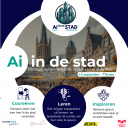Recap: Smart Data, Smart City #2. How can you assemble all transport providers into one mobile service, MaaS (Mobility as a Service)? Data sharing seems like a good first step.
How can you assemble all transport providers into one mobile service, MaaS (Mobility as a Service)? Data sharing seems like a good first step.
The third MaaS Meetup was a collaboration between the Amsterdam Economic Board and Amsterdam Smart City. The meetup was hosted at DataLab as part of Amsterdam Smart City’s Smart Data, Smart City event series. Tijs Roelofs (Smart Mobility Manager at the City of Amsterdam) immediately kicked off by sharing his personal details with the audience: a picture of his two sons, his Honda Jazz parked in front of his house, his bike and the 550 euro his family monthly spends on transportation.
Level playing field
Roelofs’ wish for the future? Freedom of Mobility. He wishes access to all transport means. A mobility platform which is easy to use, trustworthy and affordable. Or to put it in other words: tailor-made mobility like Roelofs elaborated on in his MaaSterplan. According to Roelofs this new way of organizing mobility is an absolute necessity in Amsterdam. While there is an increase in citizens and employment opportunities there is a decrease in parking spots and space. Simultaneously the market is changing: internet companies like Uber are growing rapidly and will quickly start to dominate other transport companies.
‘If we do not take action, one party will dominate the market,’ states Roelofs. That is why it is important to collaborate, to share transport data and above all keep the system as open source as possible. Not only will this create a level playing field for providers it also creates different options for the user. Roelofs: ‘In the end you would like to match supply and demand.’ When everybody supplies data the municipality - will get a great overview. Which could be used to stimulate alternative means of transport.
Robust system
How can you actually match supply and demand? How do you interpreter those different data sets? According to Diana Vonk Noordegraaf (senior consultant Smart Mobility at TNO) it is important to keep an eye on the robustness of a mobile platform like MaaS constantly. What will happen after a minor incident? Imagine the A10 gets a major overhaul and an accident has happened at the A9. Vonk Noordegraaf shows Amsterdam’s redlined traffic map. What is the disturbance’s impact? Can you design a system that is less vulnerable?
One of the solutions Vonk Noordegraaf provides is to monitor and keep looking . ‘Start by asking yourself what you can add to MaaS.’ What is the commuter’s opinion about the app? How do commuters want to use the app? The next step is to take the measurable parameters into account, like travel time. Finally you add extra data: from public transport data to weather forecasting data. It is all about the circular process: from simulation models, a thorough MaaS design, followed by pilots. At the end of the trajectory you start to monitor and adjust. ‘Each phase in the circle is crucial.’ The data’s sum is the flywheel to complete the circle.
The End of private property
MaaS in practice is Peter Krumm’s, head strategy and innovation at Connexxion, speciality; 'We collect a lot of data, however data that could cause a privacy violation is not allowed to be shared. There are some valid arguments for that. And as a public organization we have to respect that.'
However he calls out to the government to enable transport organizations to share more data. ‘Many stakeholders ask Connexxion’s permission to access our data. It would be ridiculous for Connexxion to develop a public transport app without the data of competitor Arriva. A growing number of parties seeks the same kind of information. It is all about matching those quests.’ At Connexxion they know it for quite some time: you need to collaborate!
Hope to see you all at the next Smart Data, Smart City event 18th of May






Definitely we need more data. But not undefined data. I liked Tijs Roelofs' small narrative. It is an example of a user case. I feel that we need many more user cases in order to understand better people's mobility needs. With other words, we need not only high level aggregate quantitative data, but personal level qualitative data as well.
Thanks for the report. Couldn't join!